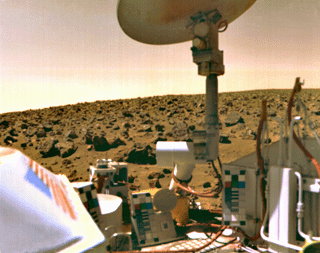A new interpretation of data from NASA’s Viking landers indicates that 0.1% of the Martian soil tested could have a biological origin.
Dr Joop Houtkooper of the University of Giessen, Germany, believes that the subfreezing, arid Martian surface could be home to organisms whose cells are filled with a mixture of hydrogen peroxide and water. Dr Houtkooper described how he has used data from the Gas Exchange (GEx) experiment, carried by NASA’s Viking landers, to estimate the biomass in the Martian soil.

Dr Houtkooper said, “The GEx experiment measured unexplained rises in oxygen and carbon dioxide levels when incubating samples. If we assume these gases were produced during the breakdown of organic material together with hydrogen peroxide solution, we can calculate the masses needed to produce the volume of gas measured. From that, we can estimate the total biomass in the sample of Martian soil. It comes out at little more than one part per thousand by weight, comparable to what is found in some permafrost in Antarctica. This might be detectable by instruments on the Phoenix lander, which will arrive at Mars in May next year.”
Dr Houtkooper and his colleague, Dr Schulze-Makuch from Washington State University, suggest that a hydrogen peroxide-water based organism would be quite capable of surviving in the harsh Martian climate where temperatures rarely rise above freezing and can reach -150 degrees Celsius at the poles. A 60% solution of hydrogen peroxide has a freezing point of -56.5 degrees Celsius, and the supercooling properties of such mixtures could mean that metabolic activity could survive at even lower temperatures. In addition, hydrogen peroxide-water solutions tend to attract water, which means that organisms could scavenge water molecules from the Martian atmosphere.
The downside of the water-scavenging biochemistry is that if the organisms were exposed to liquid water or warm atmospheres with high humidity, they could die through over hydration. In this case, the cell would break down, releasing oxygen. Any organic compounds could then react with the hydrogen peroxide, releasing carbon dioxide, water vapour and traces of nitrogen and minor constituents.
Dr Houtkooper said, “This hydrogen peroxide-water hypothesis could provide answers for several aspects of the Viking results that remain unexplained thirty years on. The concept of this type of life is also interesting for planners of future missions searching for life on Mars. With the long timescales involved in planning and launching Mars landers, there is a dire necessity to anticipate what kind of life we should expect to find and where we should be looking. Organisms with the hydrogen peroxide-water biochemistry would be more likely to be active in colder areas on Mars with high water vapour concentrations, as would be expected along the polar ice fringe. Looking further ahead, a sample return mission would mean that we could use all that present technology affords to analyse signs of life. However, if the organisms were to have the chemistry we are proposing, they may well decompose completely into gases during the journey back to Earth, without leaving even a smudge behind.”
The existence of organisms with the hydrogen peroxide-water chemistry would raise interesting questions about the origins of life on Earth. Dr Houtkooper does not think that it would necessarily imply independent origins for terrestrial and Martian life. “A detailed study of the biochemistry and genetics would be needed to determine whether the life forms were related. The transfer of terrestrial organisms to Mars or vice versa is a possibility given favorable conditions for the origin and persistence of life on both planets early in solar system history. The transfer of terrestrial organisms by early spacecrafts to Mars that either landed or crashed is a possibility, but it is not plausible that these organisms evolved in a few years.“
Hydrogen peroxide is not unknown in the metabolic processes of terrestrial organisms. The Bombardier beetle, Brachinus Crepitans, uses a 25% solution of hydrogen peroxide to produce a steam explosion in the face of pursuing predators.
Dr Houtkooper said, “There does not appear to be any basic reason why hydrogen peroxide could not be used by living systems. While organisms on Earth have found it advantageous to include salt in their intracellular fluids, hydrogen peroxide may have been more suitable for organisms adapting to the cold, dry environment of Mars.”
Source: Royal Astronomical Society





Comments